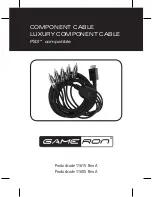
Operation Instructions | EoC 20-01 | Ethernet over Coax | Master
32
2021-03-17 | Technical improvements, changes in design, printing- and other errors reserved.
3.10.2. Radio Configuration (WIFI:RADIO)
Setup radio parameters on the AP.
WIFI Service
To activate WLAN or not.
Client Isolation (AP Isolation)
Default value to disable. To isolate the bridging between wireless clients at the same AP, and make clients
can't 'see' each other.
Start Mode (Single SSID/Multi-SSID/Multi-SSID with VLAN)
Three start modes,
∂
Standard (Single SSID): Creates a single AP, enable only VAP1 and disable VAP2/3/4.
∂
Multi-VAP (Multi-SSID): Creates a multiple Virtual Access Point (VAP) configuration, enable all VAP1/2/3/4.
∂
Multi-VAP with VLAN (Multi-SSID with VLAN): Creates a multiple VAP configuration, puts each VAP on a
desired VLAN interface, may assign VAP1/2/3/4 with different VID.
Note that “Multi-VAP” works with “Bridge Operation Mode” only, not work with “NAT Operation Mode”.
Radio Mode
Setup WLAN 802.11 b/g/n modes. Default mode is “11gn HT20”. 802.11n could span over 20MHz channel
width(HT20, maximum bit rate 144Mbits) or over 40MHz channel width (HT40, maximum bit rate 300Mbits).
Refer the following table.
Name
Description
11b
Standard Legacy DSSS rates in 2.4GHz band
11g
Standard Legacy rates in 2.4GHz band
11gn HT20
11n rates limited to HT20 MCS rates in 2.4GHz band
11gn HT40+
11n rates up to HT40 MCS rates, using upper extension channel, 2.4GHz band
11gn HT40-
11n rates up to HT40 MCS rates, using lower extension channel, 2.4GHz band
Maximum TX Power
Set the maximum allowable transmit power for all packets on the device. This power is limited by the
regulatory
limits encoded into the device, and selected by setting the country code. The value is provided in units of dBm.
Here's the typical TX power range, it is dynamic and depends on WLAN mode and WLAN bit rate.
∂
802.11b: 16.5dBm
∂
802.11g: 16.5dBm~13.5dBm
∂
802.11n HT20: 16~11.5dBm
∂
802.11n HT40: 15~11dBm
Channel
Selects the channel that the AP will operate in. Default is Auto.
Hide SSID
∂
Enable
The WiFi network name is not sent, so it is not visible to WiFi clients.
∂
Disable
The WiFi network name is being sent, so it can be seen by WiFi clients.













































